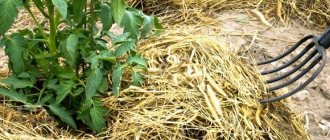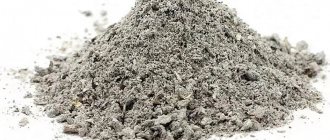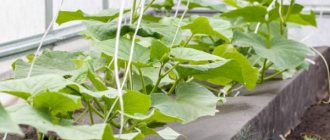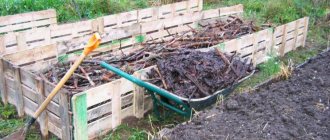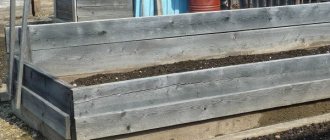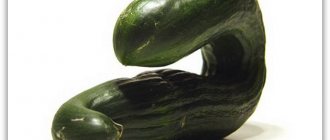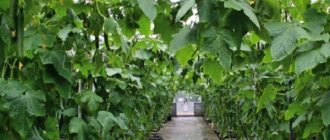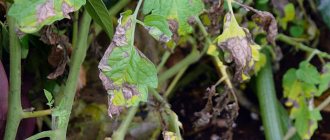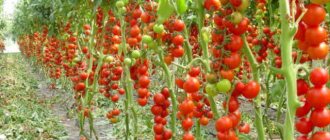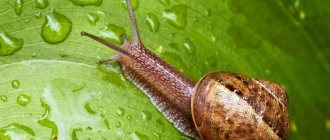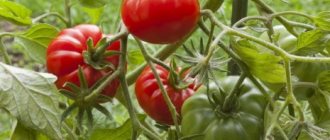Mulching cucumbers allows gardeners not only to increase the yield, but also to provide good protection against drying out of the soil and the active germination of weeds. The beneficial effect on the soil also includes soil enrichment. For mulching, you can use two types of coatings:
- Natural. This includes hay, sawdust, chopped grass, and so on. The disadvantage of this option is the need to regularly update the coating. But an additional bonus will be the constant fertilization of the soil.
- Artificial. For this purpose, spunbond or polyethylene is used. You can also use gravel or pebbles.
Pros and cons of mulching cucumbers
One of the main dangers for cucumbers is sudden changes in temperature, which can destroy the crop. Mulching helps to cope with this problem. In addition, the protective coating maintains a normal level of soil moisture and prevents it from drying out. Another advantage is that the number of weedings is reduced. Weeds do not germinate well in closed soil. So, what are the benefits of mulching?
- Provides a good level of soil moisture.
- Reduces the number of weeds.
- Covered soil does not overheat in hot weather and does not freeze during frosts.
- During irrigation, water is distributed evenly over the soil, there is no waterlogging.
- Pathogens do not transfer from the surface of the earth to shoots.
- The soil structure becomes much better, the soil is not subject to erosion.
- Mulching protects the soil from the formation of a hard crust, which prevents water and fertilizers from being absorbed.
- The coating creates a favorable environment for the emergence and development of beneficial microorganisms.
- The root system of cucumbers begins to develop more actively.
Even if you mulch just once, the crop will ripen about two weeks earlier. The shoots do not have to be hilled. Cucumbers receive significantly more nutrients, and the fruits are better protected from adverse factors. Even their taste improves.
But there are also disadvantages. Thus, not only beneficial microorganisms can develop, but also pathogens. There is also a high probability of fungus appearing. Another problem is nitrogen deficiency, which can cause mulching.
Why is it recommended to mulch the soil in cucumber beds?
Mulching is an agrotechnical technique that involves covering the ground with a special material. Many gardeners underestimate the positive qualities of this procedure. However, it has a positive effect on plants: it accelerates development and protects from adverse weather conditions.
Proper mulching of beds leads to:
- increasing soil fertility - organic mulch gradually rots, enriching the soil with nutrients;
- improving soil breathability - cucumbers do not suffer from a lack of oxygen and carbon dioxide, which allows them to grow normally;
- preservation of soil properties - prevents leaching and weathering;
- acceleration of fruit ripening - plant roots are not affected by temperature changes, due to which they develop faster;
- reducing the frequency of watering - the mulched substrate evaporates less moisture;
- there is no need for loosening - the earth does not cake, remains light and porous;
- reducing the number of weedings - dense covering prevents the growth of weeds;
- refusal to dig - just loosen the area;
- preservation of the harvest - cucumber fruits do not come into contact with the soil, which prevents them from rotting.
The more organic residues in the soil, the higher the fertility. Soil microflora is responsible for the formation of humus. Under the mulch, suitable conditions are created to enhance its activity.
Cucumbers are sensitive to soil moisture levels. Mulch prevents water from evaporating, which has a positive effect on productivity.
How to mulch cucumbers in a greenhouse and open ground: step-by-step instructions
In order for mulching to be beneficial and for the shoots not to be damaged, it is important to adhere to certain rules. There are three ways to distribute mulch. They are suitable for cucumbers in greenhouses and open ground:
- Solid. The bed with seedlings is completely covered with mulch in an even layer.
- In rows. The mulch is distributed on separate rows, the row spacing remains free.
- Nests. A small area around each shoot is covered with a layer of mulch. This option prevents the appearance of weeds well, but does not ensure the maintenance of a normal level of soil moisture.
Read the article on how to make a greenhouse and greenhouse for cucumbers, incl. made of polycarbonate with your own hands.
What steps should you take to properly mulch?
- Soil preparation. Remove old mulch if there is any. Weed out the weeds. Leave the area to dry and warm up.
- Loosening. The top layer is dug to a shallow depth. Only 10-12 cm will be enough.
- Coverage distribution. The mulch is laid evenly, the layer thickness should be no more than 5 cm. A small area around the stem should remain free.
- Now you can start working with the plantings. The mulch must be watered immediately to begin the composting process. From time to time it is necessary to look under the covering in order to notice the appearance of diseases or pests in time.
After the season is over, the mulch becomes humus. All residues are destroyed, as they may contain viruses and pathogens.
Important! If cucumbers grow in open ground, the layer of mulch must be renewed more often, as it will compost faster.
Materials used for mulching bushes
Before you begin your planned activities, do not forget to select the material. A comparative analysis will help you understand how to mulch cucumbers planted in open ground or a greenhouse.
Grass
A freshly cut layer of grass will attract slugs and other pests, so the material will have to be dried before use. You will also need to monitor the quality of the grass; it should not rot. Such material will spoil the yield and lead to the death of the plant.
Freshly cut grass is the most affordable organic material that can be used in a garden. Weeds can be mowed in vacant lots and then used for the benefit of the harvest.
Attention! The grass should be laid in a layer of 7 centimeters to achieve the desired result. But you should not take grass with seeds, since the seeds will germinate once they get into the soil.
Leaves
They are ideal as organic matter, but such material is used not when growing cucumbers, but before preparing the land for planting. Fallen leaves are collected, dried, laid on the ground in a dense layer and left for the winter. This material performs several functions and allows:
- Protect the soil and plant roots from frost.
- Acts as an organic fertilizer.
- Increases productivity and improves soil characteristics.
The disadvantage of this technique is that it is necessary to use organically pure material, which means that it is not recommended to use foliage from city parks and alleys, it will not be of any use.
If you decide to visit a pine forest, then collect needles; pine needles can also be used as an organic material suitable for mulching.
Sawdust
Requires special training. Before carrying out the procedures and use, the shavings will have to be processed, otherwise they will “take” nitrogen from the soil.
How does the preparation go:
- you will have to sprinkle sawdust on the film;
- they will have to be covered in several layers;
- You will need to water the sawdust and use urea.
Typically, the shavings are laid in 2 layers; 1 layer will require about 200 grams of urea. It is laid out on top. It is better to leave the sawdust for the winter so that it rots a little - this material does not require processing, it can be used for mulching.
Neutral peat
If you decide to use peat, keep in mind that the effectiveness of the procedures directly depends on several factors:
- What material do you use (peat characteristics).
- In what soil is the plant planted?
See also
Instructions for use of the drug Peat hydrohumate for cucumbers
Read
Straw cutting, dry grass
This type of material should also be classified as organic; it can be used if the straw or cuttings rot. In this case, there is a high probability of plant death, since low-quality material will attract pests.
Manure, humus, compost
Manure is not used in its pure form, despite the fact that it enriches the soil with nitrogen. It should be mixed with dried grass. Hay and manure will provide additional nutrition for the cucumbers. Typically, this type of mulching is resorted to if vegetables are grown on poor, meager land.
Covering artificial material
We will talk about film and agrofibre, which are used to increase crop productivity. Use ready-made material with holes cut for the plant. You can cover the soil with film in advance. But, regardless of what is used - agrofibre or film, this technique has one drawback - in the summer heat, under cover, the soil overheats.
Bulk artificial material
We are talking about mulch that protects the soil and covers it - it can be crushed stone, pebbles, sea pebbles, expanded clay. If you give them preference, then:
- protect the stem and foliage of the plant;
- Make sure that the material does not come into contact with the cucumbers.
Help: it is better to use expanded clay for cucumbers, but much depends on the characteristics of the chosen variety.
Mr. Summer Resident warns: mistakes when mulching
Improper mulching will not only not give the desired effect, but can cause harm to plants. Therefore, our portal https://mrdachnik.com reminds you that you need to pay attention to all factors - soil type, weather. Here are a few of the most common errors:
- The shoot touches the mulch. This is the cause of diseases. There must be a small free space near the stem (tops).
- Organic mulch should not be fresh, otherwise it will serve as a bait for pests.
- Inorganic types of coating should not be used in regions with hot climates, as they will cause severe overheating.
- The soil must warm up well before laying mulch.
- If sawdust or shavings are used, spreading them over the ground in rainy weather is unacceptable. They will swell and block the access of oxygen to the root system.
The soil must first be loosened and weeded. The organic coating must be renewed periodically. If symptoms of the disease are detected, the mulch layer is immediately removed.
When should it be done?
To avoid harming the plant, carry out the procedures within a certain period of time:
- soil treatment is carried out before planting, but it is not allowed to dry out;
- then the plant is planted and watered if necessary;
- it is advisable to use fertilizers;
- procedures are carried out in spring or summer, depending on the characteristics of the crop.
See also
Description of the cucumber Khrustik f1 and methods of growing the variety
Read
Early ripe cucumbers are covered with mulch in the spring, especially if planted in the ground. And in greenhouse conditions, when there is no need to protect the roots of the plant from the cold, you can begin carrying out similar procedures later - at the beginning of summer, when the cucumbers get stronger.
If the soil seems dry, then water it, otherwise this is not required, since the soil contains natural moisture. You can water a few days before the planned planting.
Answers to common questions
Question No. 1 . How to mulch the beds with film, and what type to use?
Any plastic film is suitable, it is advisable to choose a transparent material. Cucumber seeds are sown in open ground, and then the crops are covered with film. After the shoots appear, an incision is made in the film over each sprout. The mulch can not be removed until autumn.
Question number 2 . How to care for mulch?
All care comes down to watering, restoring the thickness of the layer and removing weeds (if they grow through the mulch layer). If straw or hay was chosen, the mulch is periodically ventilated and checked for rodents and other pests. Mole crickets and moles often dig tunnels under a layer of straw and thereby damage the crop.
Question number 3 . When to mulch cucumbers?
If inorganic material is used, then the soil is mulched after sowing the seeds or the seeds (seedlings) are placed in the holes of the film. If organic matter is used, mulch is applied after germination. During the season, the mulch layer is replenished as it settles.
Question number 4 . How to prepare compost as mulch?
Everything that can be decomposed by microorganisms is put into compost. Suitable items include food waste, vegetable peelings, rotten vegetables and fruits, grass clippings, green manure, straw, sawdust, leaves, manure and paper. All ingredients are crushed, placed in a barrel or compost heap and wait for them to decompose. This takes from six months to one and a half years, depending on the composition of the compost heap.
Question number 5 . I've heard about lawn mowers with a mulching option. Is such a purchase justified? Which brand should you choose?
If there is a need to fertilize the area where the lawn grows, then such a lawn mower is simply irreplaceable. It chops the grass quite finely and scatters it around the area. After a while, the mowing is practically invisible. The main thing is to mow often, several times a week, otherwise there will be no mulching effect. Popular lawn mowers include Vking Ma 443.1 C, MTD SMART 32 E, Monferme 25197M and Bosch Rotak 32.
Why mulching is not always appropriate
In addition to the advantages, you can always find significant disadvantages. They relate to the material with which mulching is carried out.
Many people think - is it possible to cover your cucumbers with sawdust to make them feel good? And they do mulching, not taking into account the fact that after swelling, wood chips retain moisture for a long time, which is not always good for the roots and can impede their natural ventilation.
Also, pouring freshly cut grass onto the beds attracts the attention of slugs. Cucumbers generally love acidic soil. Therefore, many types of mulch are not suitable for them. And you must always remember this!
Another way (alternative)
Mulch can also be created by using clear polyethylene, which is otherwise unsuitable for use. With this method, cucumber seeds are planted in the ground and covered with a transparent thick film (not too tightly). As soon as the first shoots of cucumbers appear, the shelter does not need to be removed: only holes are cut there - in the place where the cucumbers grow.
When creating such a high-quality greenhouse, not only cucumbers, but also weeds will naturally germinate perfectly, but they do not need to be removed: at first it will germinate, but soon it will die off under the influence of high temperature and humidity. It is necessary to water such mulch very rarely; weeding and loosening are not necessary.
Mulching of cucumbers is carried out immediately after germination or planting of seedlings. If black film is used, then planting is carried out even in the cover of the bed.
zelenfermer.ru
The best predecessors of cucumbers
Before planting cucumbers in the garden, remember what grew in this place before them. This crop can be planted after the following crops:
- all varieties of cabbage help loosen the soil;
- legumes and peas - form nitrogen-fixing bacteria on their roots, which improve the characteristics of the soil and make it more fertile;
- nightshades (tomatoes, peppers) - have bactericidal properties (they disinfect the soil on which they grow);
- onions, especially those grown from sets;
- potatoes, rapeseed, alfalfa, rye, mustard, clover and barley - increase the acidity of the soil, so they will be good predecessors of cucumbers in areas with low pH.
Useful properties and disadvantages of each type of mulch for cucumbers:
- Mulching with sawdust and tree bark repels slugs. When sawdust and bark rot, nitrogen is released. The required layer is 3-5 cm. Apply in the first half of summer, when the weather is hot. During the rainy season, it is saturated with moisture, which does not evaporate for a long time. It is better to use coarse wood chips.
- Straw repels slugs, retains heat and protects against frost. Reduces nitrogen content in the soil. The required layer is 10-15 cm. Apply in the first half of summer, when the weather is hot. During the rainy season, it is saturated with moisture, which does not evaporate for a long time.
- Peat saturates the soil with useful substances, prevents the development of pathogenic microflora, and retains moisture. Cover the soil with a layer of 5-7 cm. They are not removed from the beds for the winter, they are left as fertilizer.
- Needles and cones contain few nutrients, have virtually no effect on soil fertility, but have an antibacterial effect. Only rotted pine and larch needles are used. Lay in a layer of 3 cm.
- Fallen leaves protect against temperature changes and retain heat. Use only in hot weather. When it rains, the foliage rots, which leads to diseases of the cucumbers.
- Manure is often used with straw in a 1:1 ratio. It is not used in its pure form. For cucumbers, they are used only in cold climates and heavy rains. In the South, manure is not used as mulch for cucumbers.
- Compost has a neutral reaction, saturates the soil with humus, and contains many beneficial bacteria. Lay a layer of 5 cm. They are not removed from the beds for the winter, they are left as fertilizer. Rotted compost is the most valuable organic fertilizer, because it does not contain weed seeds. Pig manure and bird droppings are not used as mulch.
What is mulching
Mulching is the covering of the top layer of soil with materials of natural and artificial origin in order to protect and improve its fertile properties .
The word “mulching” is derived from the English word mulch, translated into Russian meaning “to cover, cover.”
The process allows:
- Maintain natural soil moisture;
- Reduce the amount of weeds;
- Prevent overheating of the soil surface in summer and freezing during frosts;
- Distribute water evenly over the soil surface during precipitation and watering;
- Prevent the transfer of harmful bacteria and fungal diseases from soil to plants;
- Improve the structure of the soil and ensure its looseness, porosity, and moisture permeability;
- Prevent the process of soil erosion (destruction);
- Prevent the formation of crust on the soil to improve the absorption of water during irrigation and liquid fertilizers during root feeding;
- Create conditions for the reproduction of beneficial microorganisms;
- Promote the accelerated process of formation and development of the root system .
Mulching prevents weed growth
